Quick Links:
Probiotic Facts and Myths
Did you know you are a walking and talking rainforest? Recent advances in genetic testing have allowed scientists, for the first time, to really start understanding the microorganisms living inside the human gastrointestinal tract.
Not only are they mapping flora from all over the body, but they are they studying associations between changes in the microbiome (all the species of microorganisms living on and inside you) and resulting health or disease. And, the results coming from the Human Microbiome Project (HMP) have been astonishing!
Little Known Microbiome Facts
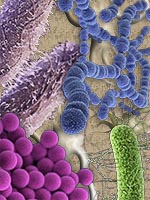 |
|---|
Your body would not survive long without the trillions of microorganisms that generate vitamins, ward off infections and regulate your immune system. |
- Did you know that you are more bacteria than human? Your body contains 100 trillion bacterial cells but only 10 trillion human cells.
- Bacterial genes in your body outnumber human genes by over 150 to 1. Mounting evidence suggests that your gut bacteria share genetic material with you.
- More than 1000 different microorganism species make up your microbiome.
- Evidence that many chronic diseases like IBS, Crohn's, asthma and obesity are associated with the disruption of optimal intestinal flora.
- Pathogenic strains of bacteria are normal inhabitants of the GI tract, like H. pylori and C. difficile.
- 80% of your immune system's function is related to your microbiome, so you want to keep your microbiome happy and healthy.
- The health of your microbiome is tied directly to acute gut infections like C. diff as well as long-term health conditions like inflammation, IBS and other chronic diseases.
As you've learned in the book C. diff. Treatments & Remedies, antibiotic drugs weaken your immune system by killing off many of the good bacteria living in your gut. The resulting imbalance of your microbiome can trigger an overgrowth of C. difficile bacteria in your gut, leading to a dangerous infection.
Microbiome Stressors
In addition to antibiotics, other factors also have a negative effect on your microbiome:
- Anti-bacterial soaps negatively affect your protective skin microbiome
- Chlorinated water
- Non-organic meats or dairy tainted with antibiotics
- Chemotherapy
- NSAIDS like Advil or Motrin
- Weed killers like glyphosate
- GMO foods and processed foods
- Lack of quality sleep and stress
Any of these factors can cause a significant decrease in your protective body and intestinal flora.
The Dirt on Probiotics
It's easy to think that if you've tried one probiotic, you've tried them all. Nothing could be further from the truth. It's likely you've tried probiotics before and didn't notice any difference. There could be several reasons for that...
- Good probiotic products should contain species of flora that are found naturally in the human gut and in the environment.
- A quality product should have high numbers of "good" strains for maximum potency.
- A quality probiotic should contain no disease-causing strains of flora.
- And importantly, an effective probiotic must contain species that can survive your stomach and make it into your intestines where they are needed.
Unfortunately, according to the Food Safety Authority of the UK1 and multiple scientific publications, more than 90% of probiotic product strains are killed by your stomach before ever reaching your intestines!
There have also been several documented cases of probiotics mislabeled with the wrong strains and containing far lower potency than claimed. In some cases, disease-causing strains were found in the products, even though they were not listed on the label.
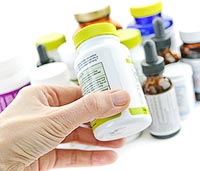 |
|---|
More than 90% of all probiotic products on the market are unstable and die inside your stomach before reaching the intestinal tract where they are needed. Photo credit: © Elenathewise/Fotolia |
In a new study by the University of California, 16 store-bought probiotic products were tested and compared to the species listed on the label. Alarmingly, only 1 of the 16 products matched the bifidobacteria species claims listed on the label2!
Many probiotics also require refrigeration. If a probiotic is so fragile that it requires refrigeration, how it is supposed to survive the warm, acidic conditions and the harsh digestive juices inside your stomach? How can such a fragile product make it into your intestines alive?
The answer is quite simple: most probiotics do not survive the journey through your stomach at all.
The truth is, there are real probiotics and there are fake probiotics. It's important that you understand the difference between the two and what to look for in a real probiotic.
What Makes a "Real" Probiotic?
The World Health Organization and Food and Agriculture Organization of the United Nations define a real probiotic as follows, with three key requirements:
"Live microorganisms, which when administered in adequate amounts confer a health benefit on the host3.”
Survivability
The first requirement for a real probiotic is that living microorganisms must reach your intestines and not be killed in your stomach. This important requirement means that 90% of probiotic products are actually fake, lacking the survivability needed to reach your intestines.
Fortunately, some bacteria form spores. These hard protective shells are like a coat of armor that allows the bacteria to survive the journey through your stomach 100% intact.
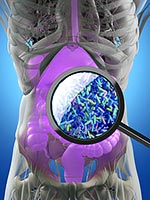 |
|---|
True probiotics must be the right species to be compatible with your gut. They must also survive the stomach and make it to the intestines. And their potency must be high enough to stimulate your GI tract flora to provide health and immune benefits. Photo credit: © Anatomy Insider/Fotolia |
GI Tract Stimulation
The second requirement is about "adequate amounts" of microorganisms. Most consumer probiotics contain Lactobacillus and Bifidobacterium species, often claiming to contain billions of organisms per capsule.
But the gut can contain well over a trillion organisms of these two species (a thousand times more). Supplementing with such products makes little or no impact on your gut flora because the billions of organisms in the product are just a drop in the bucket compared to the trillions already inside your gut.
To make a real impact, the number of cells in the product has to exceed the number already inside your gut; something that most probiotic products don't even come close to achieving.
Natural and Stable
The third requirement for a true probiotic is that it provides health benefits to your body. The Human Microbiome Project and leading probiotic experts agree that to provide benefit, a probiotic must contain organisms that naturally occur in your gut, that are a normal part of your environment and that are stable in both places.
Bacillus Sporebiotics Target Disease-Causing Bacteria
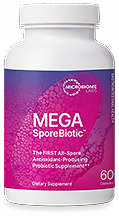 |
|---|
Spores are natural survivors, and some Bacillus species are found both inside the human gut and in the soil and the environment. Bacillus probiotics have been used around the world for decades. Our favorite "real probiotic" is physician's strength MegaSporeBiotic.
The Bacillus species in this formulation have been shown to aid digestion, reduce intestinal inflammation, colitis and pain, control intestinal bacterial overgrowth, and help with IBS and SIBO symptoms. Plus several of these Bacillus strains actually target and inhibit C. difficile bacteria. Click here to learn more.
The Role of "Special Forces" Probiotics
MegaSporeBiotic, a "real probiotic", should meet the needs of most people. But if you have specific challenges, like chronic, active diarrhea related to antibiotic use (AAD) or C. difficile-associated diarrhea (CDAD), a more specialized probiotic can provide extra support.
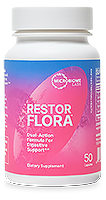 |
|---|
Special-purpose probiotics may not meet the standards of a "real probiotic" as detailed above, but they can be a good way to speed your recovery. Some types of microorganisms have unique properties (like a specialized army unit) that make them especially effective against specific symptoms or challenges. Probiotics that contain these "special forces" are usually taken temporarily until a specific symptom has resolved.
This probiotic blend is specially formulated for extra support for diarrhea, antibiotic-associated diarrhea, C. difficile-associated diarrhea and gut discomfort. Click here to learn more about our "special forces" probiotic.
Michelle's Recommended Probiotics
Not all probiotics are created equal. MegaSporeBiotic and RestorFlora are physician's-strength, spore-based probiotics that can survive harsh stomach acid and arrive in your gut at full potency.
MegaSporeBiotic is for long-term digestive and immune support. RestorFlora is for short-term extra support with C. diff. diarrhea, antibiotic-associated diarrhea and gastrointestinal upset. Get the exact level of support you need with the following cost-saving kits:
BASIC
• FREE PROBIOTIC USE E-BOOK
• ONE MEGASPOREBIOTIC
• SAVE 10%

MegaSporeBiotic
$60 $53.99
PLUS $5.49 USA SHIPPING
GET STARTED
NOW
EXTRA SUPPORT
• FREE PROBIOTIC USE E-BOOK
• RESTORFLORA & MEGASPOREBIOTIC
• SAVE 10% PLUS FREE SHIPPING
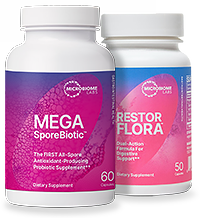
CD Probiotic Pack
$114 $102.55
FREE SHIPPING (USA ONLY)
GET STARTED
NOW
BEST VALUE
• FREE PROBIOTIC USE E-BOOK
• TWO MEGASPOREBIOTIC
• SAVE 10% PLUS FREE SHIPPING
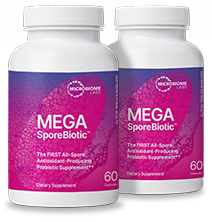
MegaSpore Value Pack
$120 $107.98
FREE SHIPPING (USA ONLY)
GET STARTED
NOW
We’re Here to Support You
Michelle strives to provide you with the best value and personal assistance on the most effective products. Michelle and her staff are here to answer your questions, walk you through her protocols and methods and to provide ongoing support on your path to health.
As a reader of Michelle's book, you get everyday savings plus special discounts when you order from our secure and private Embrace Health Naturals web store. You also get FREE SHIPPING on U.S. orders over $99.
Quick Links:
References:
1. The Food Standards Agency conducted a study in conjunction with Reading University (Dr. G.R.Gibson, Dr. G. Rouzaud, Dr. J. Brostoff and Dr. N. Rayment) in the United Kingdom to evaluate the probiotic effect of commercial products in the human gut, and whether there was any impact on gut flora. The study evaluated the survivability of common probiotics through the gut,examining 35 strains from commercial products, primarily Lactobacillus sp. and Bifidobacterium sp.
2.
Validating bifidobacterial species and subspecies identity in commercial probiotic products, Lewis ZT, Pediatr Res. 2016 Mar;79(3):445-52.
3. Guidelines for the Evaluation of Probiotics in Food http://www.who.int/foodsafety/fs_management/en/probiotic_guidelines.pdf







